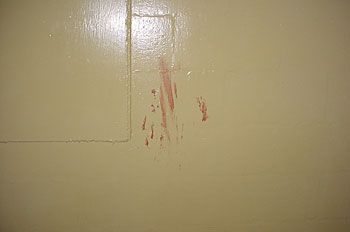Painting The Town Red Still Won’t Hide Bloodstains
Not a single drop of his blood was visible. Not even a speck.
Yes, four coats did the job nicely.
Her lips split into a wide grin as she admired her work. Picasso himself couldn’t have done a better job.
Satisfied, now that police would never locate a single clue, Ida Dunit began the task of putting away the drop cloth, a half-empty gallon can of Midnight Blue paint (guaranteed to cover anything in a single coat), and the green fiberglass stepladder, his favorite. Then she placed the brush and roller cover, both still dripping with the blue goo, into a plastic garbage bag, which she promptly placed in the can sitting at the curb.
After all, there’s no better day than garbage day to murder a husband.
She hadn’t felt this good in years.
Well, Ida, your plan would have worked were it not for the idea of Glenn Porter, an Australian who just happens to be an expert in forensic photography. You see, Ms. Dunit, the Australian fellow, a student at the University of Western Sydney, had a brilliant notion that will help police catch killers like you.
First of all, Porter knew that infrared light, light with longer wavelengths than visible light, has the ability to penetrate layers of paint. So, using an ordinary digital camera, he simply swapped the filters, allowing only infrared light to be recorded. The result…well, let’s just say, Ms. Dunit, that the police are in the process of issuing a warrant for your arrest as we speak.
Yes, this simple, yet remarkable process allows blood to be seen even under six coats of black paint. Other colors are just as easily penetrated by the infrared light, such as orange, purple, yellow, green, and yes, Ira, even your color of choice, Midnight Blue. Even six coats of bright red paint, the color of fresh blood, can’t hide the evidence from the camera.
The only difficulty found was with white acrylic paint. The camera could not “see through” as little two layers of it.
And, for those of you who love a twist, Mars Brown might be the paint color your villain would want to stock in his tool shed, since it contains iron oxide-based pigments…basically the same stuff (iron) that makes blood visible to the infrared camera. Therefore, blood stains, no longer distinct from the surrounding hue, would simply blend in with the wall color.
And now, Ms. Ira Dunit, you have the right to remain silent. Anything you say will be…
*Photos – Wikipedia Commons






Very entertaining and educational, Lee! Is this widely known and used yet in all civil law enforcement agencies and departments? Or has it most likely gotten a start at those who attend certain lectures and seminars and will have to trickle down (unless some smart person read it somewhere in a professional publication)? How hard would it be for a department to get the filters into their budget – is it likely to be ‘chump’ change or would it have to go into an annual budget request? Thanks for the heads-up on the technology. Definitely bears looking into….
Fascinating article, Lee. I got a good chuckle out of this one. Thanks!
Lee, I love the names you come up with for your criminals. I’m putting white arylic paint on my honey-do list for hubby. lol
Love the fact that photography can help solve a bloody crime. 🙂
The email copy was received, if that’s what you’re asking.
Will an email confirm the email part ? Or just what is mailed. Thank you !
I’m not sure about Kilz, unless it falls under “white acrylic.”
WPA sends confirmations after the hard copy and entry fee is received. FYI – there’s a mountain of stories, which means it takes a while to get them all processed.
What about Killz brand paint ?
I emailed contest story yesterday. Is it two days to get confirmation ?